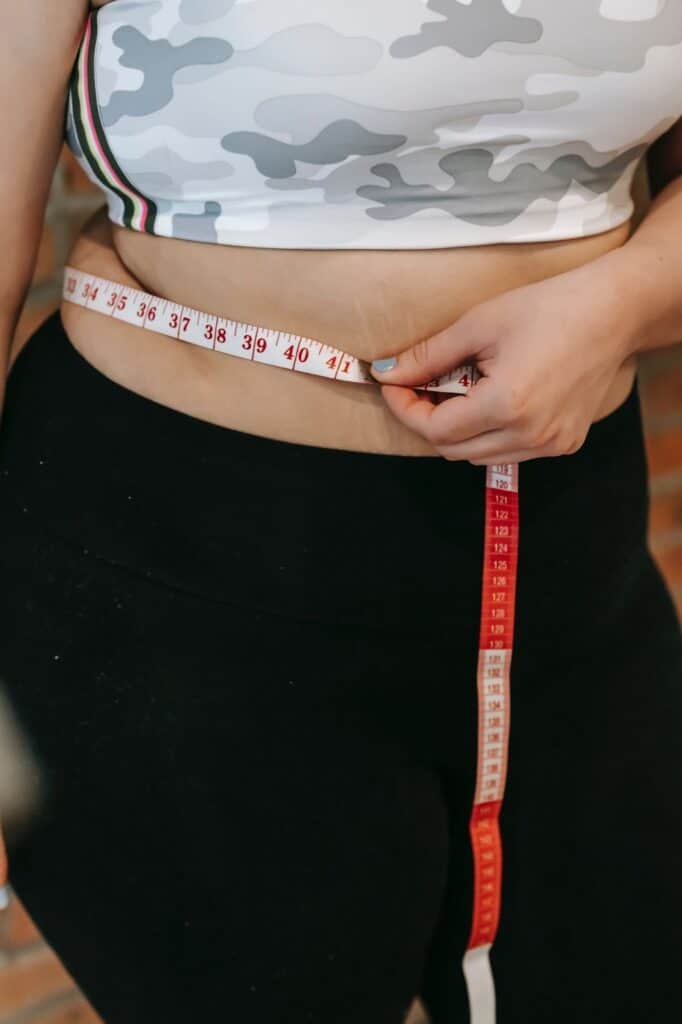Achieving visible abs is a goal for many fitness enthusiasts, but it’s essential to understand that the road to defined abdominal muscles is largely influenced by body fat percentage. While genetics play a role in how our bodies distribute fat, maintaining a healthy body fat percentage is crucial to reveal those sought-after abs. In this article, we’ll explore what different body fat percentages look like and how they affect the visibility of abs as well as how to calculate it.
Jump to:
What Is Body Fat Percentage?
Body fat percentage refers to the proportion of body weight that is made up of fat tissue in relation to lean tissue, which includes muscles, bones, organs, and water. It is a key indicator of overall body composition and plays a significant role in determining one’s level of fitness and health. Body fat percentage is often used as a more accurate level of body fat than just measuring body weight, as it takes into account the distribution of fat throughout the body from more specific body circumference measurements.
What Body Fat Percentage Do I Need to See Abs?
Achieving visible six-pack abs is a goal for many fitness enthusiasts, but it’s essential to understand that the road to defined abdominal muscles is largely influenced by body fat percentage. While genetics play a role in how our bodies distribute fat, maintaining a healthy body fat percentage is crucial to reveal those sought-after abs. In this article, we’ll explore what different body fat percentages look like and how they affect the visibility of abs.
What 20% Body Fat Looks Like
At 20% body fat, the abdominal muscles are typically not well-defined and may be obscured by a layer of subcutaneous fat. For most individuals, a portion of fat tends to accumulate around the midsection, making it difficult to see the contours of the abs. While you might have some muscle definition in other areas of the body, the abdominal region might not showcase the sought-after six-pack. However, remember that 20% body fat is still considered a healthy range for most people, and it provides essential padding and insulation for organs.
What 15% Body Fat Looks Like
As the body fat percentage decreases to around 15%, the abdominal muscles begin to become more visible. At this level, some of the fat around the midsection starts to diminish, revealing faint outlines of the abs. However, achieving a full six-pack might still be challenging for some individuals, especially if their genetics predispose them to store more fat in the abdominal region. Nevertheless, at 15% body fat, you should start to notice increased muscle definition in other parts of the body, such as the arms, shoulders, and legs.
What 10% Body Fat Looks Like
The coveted six-pack abs typically start to emerge at around 10% body fat. At this level, most individuals will have well-defined abdominal muscles, with clear separations between each of the six segments. The reduction in subcutaneous fat allows the underlying muscle structure to be more visible. As you reach this level of body fat, your hard work in the gym and dedication to a well-balanced diet will be more evident. However, it’s important to remember that achieving and maintaining 10% body fat requires discipline and is not sustainable or necessary for everyone.
What >10% Body Fat Looks Like
It’s worth noting that individuals with a body fat percentage higher than 10% can still have visible abs, depending on their genetics and muscle mass. Some people naturally carry more fat in specific areas while still showcasing muscular definition in others. Additionally, factors like water retention and bloating can temporarily influence the appearance of abs, irrespective of body fat percentage.

Visible abs are a fitness goal that requires dedication, hard work, and a combination of proper nutrition and exercise. While body fat percentage plays a significant role in the visibility of abdominal muscles, it’s essential to focus on overall health and well-being rather than solely fixating on achieving a certain body fat percentage. Everyone’s body is unique, and genetics play a crucial role in how our bodies respond to diet and exercise.
If your goal is to see your abs, aim for a gradual and sustainable reduction in body fat through a balanced approach to nutrition and exercise. Consult with a fitness professional or nutritionist to develop a personalized plan that aligns with your specific needs and goals. Remember that health and fitness are about progress, not perfection, and a well-rounded approach will lead to improved overall well-being, irrespective of the visibility of your abs.
What Body Fat Percentage Is Healthy?
Body fat percentage is a vital aspect of overall health, and maintaining an appropriate level of body fat is crucial for both men and women. While some body fat is essential for insulation, hormone regulation, and overall organ protection, excessive body fat can lead to various health risks. In this article, we’ll explore what body fat percentage is considered healthy for men and women, helping individuals achieve and maintain optimal well-being.
Healthy Body Fat Percentage of Men
The ideal body fat percentage for men varies based on factors such as age, genetics, and lifestyle. In general, a healthy and average body fat range for adult men is between 10% and 20%. Athletes or highly active individuals may have slightly lower body fat percentages, typically falling between 6% and 13%.
Having a body fat percentage below 10% can be challenging to maintain and may not be sustainable for most men. Extremely low body fat levels can lead to hormonal imbalances, reduced immune function, and potential negative impacts on reproductive health. Striving for a balanced approach to fitness and nutrition is essential to achieve a healthy body fat percentage no matter your body type.
For men, regular strength training exercises coupled with cardiovascular workouts can help reduce body fat and increase muscle mass. A well-balanced diet with appropriate macronutrient ratios, such as lean proteins, healthy fats, and complex carbohydrates, supports the journey toward a healthy body fat percentage.
Healthy Body Fat Percentage of Women
Similar to men, the healthy body fat percentage for women is influenced by various factors, including age, genetics, hormonal balance, and physical activity level. For adult women, a healthy body fat range typically falls between 18% and 28%. Female athletes or those with an active lifestyle may have slightly lower body fat percentages, often ranging from 14% to 20% as a rough estimate.
It’s important to understand that women naturally carry a higher percentage of body fat than men due to biological differences, particularly in reproductive functions and hormone regulation. Essential body fat levels, which are critical for normal physiological functioning, are around 10-13% for women.
Women should avoid excessively low body fat levels in unhealthy ranges like 1-3% body fat, as this may lead to menstrual irregularities or amenorrhea, which can negatively impact bone density and reproductive health. Instead, focus on a balanced approach to exercise and nutrition that promotes overall well-being and supports a healthy body fat percentage and not just for extreme fat and weight loss.
Strength training is beneficial for women as well, as it helps to build lean muscle mass, which can increase metabolism and aid in fat loss. Combining strength training with cardiovascular exercises and a well-rounded diet, including a variety of nutrient-dense foods, will contribute to achieving and maintaining a healthy body fat percentage.
Types of Body Fats
Our bodies store fat in various forms, and each type of fat serves distinct functions and impacts our health differently. Understanding the different types of body fats can help us make informed decisions about our lifestyle and nutrition choices. Below are five primary types of body fats:
Subcutaneous Fat
Subcutaneous fat is the most common type of fat found in the human body. It is located just beneath the skin, where it acts as a thermal insulator and helps regulate body temperature. Subcutaneous fat also provides cushioning and protection to the underlying muscles and bones. While excessive subcutaneous fat can contribute to a higher body fat percentage and obesity, small amounts of it are essential for overall health and well-being.
Visible subcutaneous fat is what we can pinch or feel when we touch our skin. Areas where subcutaneous fat tends to accumulate include the thighs, hips, abdomen, and upper arms. Aesthetic concerns often lead people to target this fat through exercise and diet, but it is essential to strike a balance to maintain a healthy layer of subcutaneous fat.
Visceral Fat
Unlike subcutaneous fat, visceral fat is stored around vital organs within the abdominal cavity. It surrounds organs like the liver, pancreas, and intestines. While some visceral fat is necessary to cushion and protect these organs, excess accumulation can pose health risks.
High levels of visceral fat are associated with an increased risk of chronic conditions such as heart disease, type 2 diabetes, and certain cancers. Unlike subcutaneous fat, this type of fat is not visible from the outside, making it a hidden risk factor for many individuals. Regular exercise and a balanced diet can help reduce visceral fat and improve overall health.
White Fat
White fat, also known as white adipose tissue (WAT), is the most common type of fat in our bodies and serves as the primary energy storage. Its main role is to store excess calories in the form of triglycerides. When we consume more calories than we burn, the excess energy is converted into triglycerides and stored in white fat cells for later use.
White fat also releases hormones and other signaling molecules that regulate appetite and metabolism. While excessive white fat can lead to obesity and related health issues, it is vital for our survival as it provides a source of energy during periods of calorie deficit.
Brown Fat
Brown fat, or brown adipose tissue (BAT), is a unique type of fat that generates heat through a process called thermogenesis. Unlike white fat, which stores energy, brown fat burns calories to generate heat and help regulate body temperature. This type of fat is more common in newborns and hibernating animals, as it plays a role in keeping them warm.
Recent studies have shown that adults also have small amounts of brown fat, particularly in regions like the neck and shoulders. Researchers are exploring the potential of brown fat activation as a way to combat obesity and improve metabolic health.
Intramuscular Fat
Intramuscular fat is fat stored within the muscles themselves. While muscles are primarily composed of protein, they also contain small amounts of fat for energy storage and muscle function. Intramuscular fat levels can vary based on factors like physical activity level and diet.
While higher levels of intramuscular fat are not typically associated with health issues, it may impact athletic performance and muscle quality. Regular exercise and a balanced diet can help optimize intramuscular fat levels and support muscle function and overall fitness.

How to Calculate Body Fat Percentage:
Calculating body fat percentage involves using various methods, some more accurate than others. Below are three common methods for calculating body fat percentage:
Body Fat Calipers Method (Skinfold Measurement): The skinfold measurement method is a simple and cost-effective way to estimate body fat percentage. It involves using body fat skinfold calipers to measure the thickness of subcutaneous fat at specific sites on the body. The most commonly measured areas include the triceps, biceps, shoulder blades, and waist.
To calculate body fat percentage using this method, follow these steps:
- Take multiple skinfold measurements at each designated site on the right side of the body.
- Add the measurements together to get the total skinfold thickness.
- Use an equation specific to your gender and age to estimate body fat percentage based on the total skinfold thickness.
Bioelectrical Impedance Analysis (BIA): Bioelectrical Impedance Analysis is a quick and non-invasive method that measures the resistance of electrical currents as they pass through the body. Fat tissue conducts electricity differently than lean tissue, allowing the BIA device to estimate body fat percentage.
To calculate body fat percentage using BIA:
- Stand barefoot on a BIA device or hold handheld BIA electrodes while maintaining good contact with the sensors.
- The device will send a low-level electrical current through the body, and the resistance measured will be used to estimate body fat percentage.
- Note that factors like hydration level and food intake can affect BIA accuracy, so it’s best to measure consistently under similar conditions.
Dual-Energy X-ray Absorptiometry (DXA): DXA is considered one of the most accurate methods for measuring body fat percentage. It utilizes X-ray technology to differentiate between bone, lean tissue, and fat mass.
To calculate body fat percentage using DXA:
- Lie flat on a DXA scanning table while a scanner passes over the body.
- The scanner will generate detailed images and measurements of bone, lean tissue, and fat mass.
- The software will then calculate body fat percentage based on these measurements.
Keep in mind that all methods have inherent limitations and may provide varying results. Environmental factors, hydration, and personal variables can influence the accuracy of these calculations. It’s essential to understand that body fat percentage is just one aspect of overall health and fitness. It’s best to interpret the results in conjunction with other health indicators and consult with a healthcare professional or fitness expert for a comprehensive assessment and guidance tailored to your specific needs and goals.














